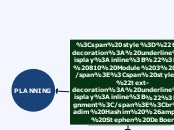Connecting Curriculum Design with Planning, Instruction, and Assessment
PHILOSOPHICAL FOUNDATIONS OF CURRICULUM
TRADITIONAL
Realism
Perrennialism
Educate rational
person
Idealism
Essentialism
Intellectual growth.
Teach the 3 R's
CONTEMPORARY
Pragmatism
Progressive
Democratic social living
Reconstructionism
Improved society
CURRICULUM DESIGN
Design Dimension Considerations
Scope
Sequence
Continuity
Articulation
Integration
Balance
Learner-Centred Designs (Ornstein & Hunkins, 2013);
Learner-Based Designs (Sowell, 2005)
Child-Centred Design
Experience-Centred Design
Romantic (Radical) Design
Humanist Design
Problem-Centred Designs (Ornstein & Hunkins, 2013);
Society-Culture-Based Designs (Sowell, 2005)
Life Situations Design
Reconstructionist Design
Subject-Centred Designs (Ornstein & Hunkins, 2013);
Subject Matter Designs (Sowell, 2005)
Subject Design
Discipline Design
Broad-Fields Design
Correlation Design
Process Designs
CONCEPTIONS OF CURRICULUM
ACADEMIA
(Al-Mousa, 2013)
Academic
Rationalist
Traditionalist
TECHNOLOGY
(Al-Mousa, 2013)
Cognitive
Processes
Systemic
SOCIETY
(Al-Mousa, 2013)
Social
Reconstructionist-
Relevance
INDIVIDUAL
(Al-Mousa, 2013)
Humanist
Self-actualization
Learner-centered
PLANNING
INSTRUCTION
ASSESSMENT
“What is needed is a balanced approach to assessment, in which appropriate techniques are administered and used in a credible way for decision making” (McMillan, 2014, p. 20)
Components
Purpose
Measurement
Interpretation
Use
Diagnosis
Grading
Instruction
Types of Classroom Assessment
Diagnostic/Pre-Assessment
Assessment for Learning
Formative Assessment
Assessment as Learning
Summative Assessment
Assessment of Learning
What does high-quality classroom assessment look like?
Clear and appropriate
learning targets
Alignment of assessment
methods and learning targets
Validity
Reliability
Fairness
Positive Consequences
Alignment
Practicality and Efficiency
Assessment Methods
Selected Response
Multiple choice
Matching
Binary/True-False
Constructed Response
Brief (e.g. Fill in blank, label
diagrams, short answer)
Performance Tasks
Product creation
Skills demonstration
Essay Writing
Oral Questioning (e.g. conferencing,
interview, oral exam)
Teacher Observation
Formal
Informal
Student self-assessment
Self-reporting/Inventory
Self-evaluation
Peer-evaluation
